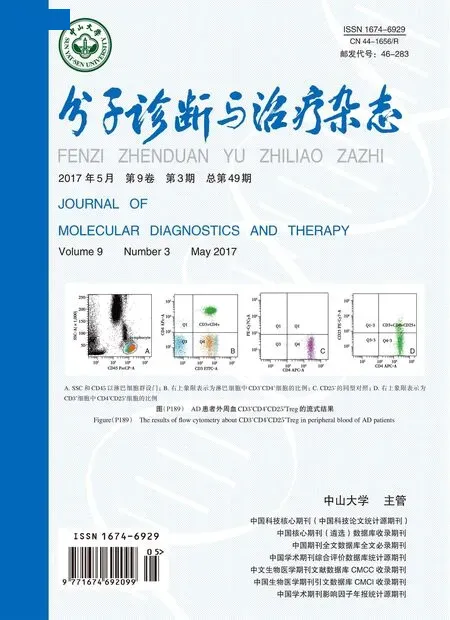肠道病毒71型感染相关遗传易感基因研究现状
黄明元林绮玲范颖曾今诚
肠道病毒71型感染相关遗传易感基因研究现状
黄明元1林绮玲1范颖1曾今诚2★
肠道病毒71型(EV71)是引起婴幼儿手足口病(HFMD)的最常见肠道病毒之一。EV71侵染取决于病毒、宿主及环境的多重作用,特别是介导EV71病毒与宿主固有免疫及适应性免疫反应功能异常相关基因的多态性与EV71易感关系密切。在此过程中,越来越多白细胞介素类(IL-4,IL-8,IL-17F和IL-18)、趋化因子类(MCP-1,IP-10)及抗病毒蛋白类(OAS,HLA)相关基因被筛选发现与EV71易感及病程恶化密切相关。本文就近年来EV71感染相关遗传易感基因筛选研究状况作一综述。
肠道病毒71型;基因多态性;手足口病;白细胞介素;趋化因子;抗病毒蛋白
肠道病毒71型(enterovirus 71,EV71)是引起婴幼儿手足口病(hand,foot and mouth disease,HFMD)的最常见、具嗜神经性肠道病毒之一。EV71侵染取决于病毒、宿主及环境的多重作用,特别是介导EV71病毒逃逸宿主固有或适应性免疫反应监视相关基因的多态性与EV71易感关系密切[1]。在这个过程中桥梁机体固有免疫及适应性免疫反应的白细胞介素类,趋化因子类蛋白也就成为了筛选EV71感染相关遗传易感基因的靶点,如IL-17F和MCP-1基因可能是通过影响其基因表达并调节炎症反应,进而影响EV71感染的发生风险及严重程度。此外,基因多态性引起的抗病毒蛋白类功能异常也成为EV71易感的重要因素,如HLA-G 14 bp-/-基因型使HLA-G的表达增多,使病毒逃避免疫监视,进而导致机体对EV71易感。因此,本文就EV71感染相关遗传易感基因研究进展作一综述。
1 白细胞介素类
1.1 IL-4基因
人白细胞介素4(interleukin-4,IL-4)基因定位于染色体5q31,其蛋白作为Th2细胞分泌的主要细胞因子介导机体体液免疫反应。EV71感染患者体内Th2细胞比例和IL-4含量均增高,且两者均随着疾病的持续进展、高烧等显著增加[2]。Zhang等[3]也发现重组的EV71病毒VP1蛋白诱导高水平的Th2细胞反应。因此,IL-4可能是EV71感染患儿病情加重的一项重要指标。尤其是IL-4通过调节MHCⅡ类抗原和FcR异常表达影响机体抗EV71感染过程。IL-4基因序列分析显示该基因存在多态性位点,特别是IL-4基因启动子区,如IL-4-589 C/T基因多态性位点。该位点与IL-4产生、活性及功能关系密切。研究发现IL-4-589 CC基因型、IL-4-589 CT基因型和IL-4-589 C等位基因与乙型肝炎病毒(hepatitis B viruses,HBV)和丙型肝炎病毒(hepatitis C viruses,HCV)易感有关[4]。此外,IL-4-33 TT基因型与人类免疫缺陷病毒(human immunode fi ciency virus,HIV)易感有关[5],IL-4-590 T等位基因与呼吸道合胞病毒(respiratory syncytial virus,RSV)易感有关[6]。最近Li等[7]发现EV71感染重症HFMD患儿中,IL-4-589 CC基因型和IL-4-589 CT基因型患儿血清IL -4含量显著高于IL-4-589 TT基因型患儿,且IL-4 -589 C等位基因与中国汉族儿童EV71病毒易感及疾病严重程度密切相关,这些研究说明IL-4基因多态性对IL-4介导的抗病毒感染过程尤为重要。因此,对EV71感染高发区儿童进行IL-4基因多态性筛查对预防地区EV71流行可能具有重要的价值。
1.2 IL-8基因
人白细胞介素8(interleukin-8,IL-8)由定位于染色体4q13-21的CXCL8基因编码,其蛋白作为单核细胞、巨噬细胞、上皮细胞、平滑肌细胞、成纤维细胞和角化细胞主要分泌的趋化因子,在趋化靶细胞(如T细胞、嗜碱性粒细胞、中性粒细胞等)到炎症位点,启动固有免疫细胞和适应性免疫细胞介导的机体抗微生物感染、抗肿瘤等方面具有重要作用。EV71感染可诱导人单核细胞衍生的巨噬细胞(monocyte-derived macrophages,MDMs)分泌IL-8。近年来,众多学者发现EV71感染引起的脑干脑炎患者血清、脑脊液IL-8含量显著增加且与重症患者中性粒细胞和单核细胞含量密切相关[8-10],而Wang等[11]也发现EV71感染HFMD患者血清IL-8含量显著增加且与疾病严重程度呈正相关,表明血清IL-8含量是重症EV71感染的危险因素,可作为EV71感染严重程度的辅助诊断指标。最近Li等[12-13]发现携带IL-8+781 C基因汉族婴幼儿易发生EV71感染且易发展成重症患儿,而携带IL-8-251 T基因汉族EV71感染HFMD患儿发生脑炎的风险更大。研究还发现IL-8-251 T等位基因还与EV71感染HFMD患儿性别、年龄、发烧天数、白细胞含量、CRP和BG浓度、IL-8含量密切相关[14]。此外,IL-8-251 T基因型还与汉族幽门螺杆菌相关胃癌、消化性溃疡、呼吸道合胞病毒(respiratory syncytial virus,RSV)易感有关[15-17]。因此,对EV71感染患儿进行IL-8基因多态性筛选,尤其对携带IL-8-251 T基因型患儿提前进行治疗干预,可能在控制患儿发展成为重症患儿中具有重要的价值。
1.3 IL-17F基因
IL-17F基因定位于染色体6p12,其蛋白主要由CD4+T细胞、CD8+T细胞、γ δT细胞、NKT细胞、LTi-like细胞和上皮细胞分泌产生,在组织炎症部位诱导释放促炎细胞因子和趋化因子中发挥着重要作用。已报道IL-17F基因多态性与多种感染性疾病易感相关。IL-17F-7488 C和IL-17 G-152A基因型均与结核易感相关[18-19]。IL-17A rs4711998遗传性变异与HBV相关的肝硬化易感相关[20]。IL-17F在抗EV71感染中起至关重要的作用。研究发现IL-17F-7488 C基因型与EV71感染HFMD患者脑炎低发生风险有关,且携带IL-17F-7488 TT基因型EV71感染HFMD患者CRP、血细胞含量、中性粒细胞含量均高于IL-17F-7488 CC+CT基因型EV71脑炎患者[21],提示IL-17F-7488 T基因可导致严重的组织炎症反应介导患儿病情加重。然而,IL-17F 7488 G基因型与中国汉族人群EV71易感及肺炎易感无关,但与突尼斯人肺炎易感密切相关[22]。因此,携带IL-17F-7488 TT基因型可作为警惕患儿并发脑炎的一项重要指标。
1.4 IL-18基因
IL-18基因定位于染色体11q22.2-22.3,其蛋白作为一种重要的促炎症细胞因子,能激活单核细胞、巨噬细胞、淋巴细胞和内皮细胞,在自身免疫性疾病及感染性疾病中发挥重要作用。EV71感染患者血清中IL-18含量明显高于正常个体[23],IL-18-607 C/A和IL-18-137 G/C基因多态性可能与IL-18的低表达有关[24]。研究发现IL-18-607 AA基因型、IL-18-607A等位基因携带儿童更易感染EV71,且IL-18-607 AA基因型HFMD患儿更易并发脑炎[25],提示IL-18基因多态性也与EV71感染患儿发展成为重症患儿有关。IL-18-607位点C变为A,阻断了cAMP应答元件结合蛋白的结合位点,继而抑制其调控的基因转录,影响IL-18基因表达水平,IL-18基因多态性可能由此参与EV71感染的发生发展。
2 抗病毒蛋白类
2.1 OAS基因
2′-5′寡聚腺苷酸合成酶(2′-5′Oligoadenylates Synthetase,OAS)是干扰素(interferon,IFN)诱导产生的抗病毒蛋白,主要由定位于染色体12q24的OAS1、OAS2和OAS3基因编码。OAS参与机体非特异性免疫和特异性免疫,在机体的抗病毒、信号转导等过程中起重要作用。研究发现OAS1 rs10774671位点GG基因型个体易患CA16型HFMD,且其IFN-γ表达水平较高,而AA+AG基因型HFMD患儿易发生脑炎[26];OAS2 rs1293762位点G/G基因型和G等位基因与俄罗斯人慢性丙型肝炎(hepatitis C,HC)患者密切相关,而T/T基因型和T等位基因与重症森林脑炎(tick-borne encephalitis,TBE)易感有关[27]。胡聪慧等[28]采用PCR-SSP技术发现OAS1 rs1131476(G/A)位点基因型AA和等位基因A汉族人群携带者在EV71感染中易发展为重症。OAS1基因多态性可能通过影响OAS1的活性,继而影响其对EV71病毒蛋白合成的抑制效果,从而引起EV71感染的发生发展。
2.2 HLA基因
人类白细胞抗原(human leukocyte antigen,HLA)基因定位于染色体6p21.31,含一系列紧密连锁的基因座,其蛋白作为人类的主要组织相容性复合体(major histocompatibility complex,MHC)与人类免疫系统功能密切相关。HLA-A33基因型常见于亚洲人群,而在白种人中少见。早期研究发现HLA-A33基因型与EV71易感关系密切,而HLA -A2基因型患儿易发生心肺衰竭[29]。人类白细胞抗原G(Human leukocyte antigen G,HLA-G)14 bp插入/缺失多态性是位于HLA-G的第3 742 bp处存在一个长度为14 bp的插入或缺失。研究发现EV71感染患儿HLA-G 14 bp-/-基因型及其血浆sHLA-G水平显著高于正常个体,且HLA-G 14 bp-/-基因型与EV71易感密切有关[30],提示HLA-G参与了EV71感染的发生发展过程,但HLA基因多态性在EV71感染中的诊疗价值还有待进一步评估。
3 趋化因子类
单核细胞趋化蛋白-1(monocyte chemoattractant protein-l,MCP-1)基因位于染色体17q11.2-12,其编码的蛋白也称趋化因子配体2[(chemokine(CC motif)ligand 2,CCL2],属于炎症趋化因子CC亚族成员,能趋化T淋巴细胞、单核细胞,诱导内皮细胞、单核细胞释放黏附因子,使单核/巨噬细胞向病变处聚集,在炎症反应、血管再生及损伤修复、肿瘤发生发展等方面发挥重要作用。研究发现CCL2-2510 G基因型与EV71型脑炎易感有关[31],而CCL2-2518 A/G基因型和CXCL10-201 A/ G基因型均与EV71易感程度及疾病恶化程度相关[32]。此外,携带趋化因子IP-10(inducible protein 10,IP-10)基因1596 C/T位点A等位基因和黏病毒抗性蛋白 A(myxovirus resistance protein A,MxA)基因启动子C-123 A及G-88 T等位基因中国汉族儿童,感染EV71的可能性均较低[33-34]。
除以上研究外,近年来研究者还发现内皮型一氧化氮合酶(endothelial nitric oxide synthase,eNOS)G894T位点T基因携带者与中国汉族人群EV71易感有关[28]。黑色素瘤分化相关基因5 (melanoma differentiation-associated gene 5,MDA5)基因rs1990760位点多态性与中国汉族人群重症EV71感染有关[35]。Toll样受体7(toll-like Receptor 7,TLR7)3号外显子371T>A位点突变可能为中国汉族人群EV71易感基因,尤其是男性患儿[36]。然而,这些基因在EV71易感中的地位还有待评估。
4 小结
随着国际人类基因组计划和单体型图谱计划的完成,遗传易感基因研究已成为当前功能基因组学的研究热点和焦点。对疾病易感基因的筛选在指导疾病的预警、预防和治疗等方面具有重要意义。近年来,对EV71感染相关遗传易感基因的研究越来越多,可知人们已经认识到基因多态性在EV71感染发生、发展中的重要作用,尤其是各种与EV71易感相关基因多态性研究及与疾病病程发展相互间的联合分析将会是今后针对EV71感染精准医疗的研究重点。文中,我们通过综述近年来筛选得到的EV71感染相关遗传易感基因发现白细胞介素类(IL-4,IL-8,IL-17F和IL-18)、趋化因子类(MCP-1,IP-10)及抗病毒蛋白类(OAS,HLA)相关基因与EV71易感密切相关,因此,对EV71易感区进行这些基因的基因多态性分析,对早期预防儿童感染,降低地区EV71感染率具有重要价值。此外,对重度EV71感染易感基因进行筛选也有可能对EV71感染患儿早期预防及治疗中具有重要意义。然而,目前这些EV71感染相关遗传易感基因的研究还处于初级阶段,其临床应用价值还有待进一步深入,尤其是这些EV71感染相关遗传易感基因在同一群体中的发生率如何?不同遗传易感基因之间是否存在某种联系?还有待进一步研究,此外,已有的研究还需要继续增加样本量,仍需在不同区域的人群中进行研究,从而使EV71感染相关遗传易感基因的研究更加深入,为揭示宿主基因多态性在疾病发生、发展中的重要作用提供依据。
[1] Pathinayake PS,Hsu AC,Wark PA.Innate Immunity and Immune Evasion by Enterovirus 71[J].Viruses,2015,7(12):6613-6630.
[2] Li F,Liu XP,Li JA,et al.Correlation of an interleukin-4 gene polymorphism with susceptibility to severe enterovirus 71 infection in Chinese children[J].Arch Virol,2015,160(4):1035-1042.
[3] Zhang F,Hao C,Zhang S,et al.Oral immunization with recombinant enterovirus 71 VP1 formulated with chitosan protects mice against lethal challenge[J].Virol J,2014,11:80.
[4] Gao QJ,Liu DW,Zhang SY,et al.Polymorphisms of some cytokines and chronic hepatitis B and C virus infection[J].World J Gastroenterol,2009,15(44):5610-5619.
[5] Chaudhari DV,Chavan VR,Kerkar SC,et al.Polymorphisms in major cytokine genes:a study among human immunodeficiency Virus-1 serodiscordant couples in Mumbai,India[J].Indian J Med Microbiol,2013,31(2):166-172.
[6] Hoebee B,Rietveld E,Bont L,et al.Association of severe respiratory syncytial virus bronchiolitis with interleukin-4 and interleukin-4 receptor alpha polymorphisms[J].J Infect Dis,2003,187(1):2-11.
[7] Li F,Liu XP,Li JA,et al.Correlation of an interleukin-4 gene polymorphism with susceptibility to severe enterovirus 71 infection in Chinese children[J].Arch Virol,2015,160(4):1035-1042.
[8] Wang SM,Lei HY,Yu CK,et al.Acute chemokine response in the blood and cerebrospinal fluid of children with enterovirus 71-associated brainstem encephalitis[J].J Infect Dis,2008,198(7):1002-1006.
[9] Zhang Y,Liu H,Wang L,et al.Comparative study of the cytokine/chemokine response in children with differing disease severity in enterovirus 71-induced hand,foot,and mouth disease[J].Plos One,2013,8 (6):e67430.
[10] Ye N,Gong X,Pang LL,et al.Cytokine responses and correlations thereof with clinical profiles in children with enterovirus 71 infections[J].BMC Infect Dis,2015,15:225.
[11] Wang W,Li W,Yang X,et al.Interleukin-8 is elevated in severe hand,foot,and mouth disease[J].J Infect Dev Ctries,2014,8(1):94-100.
[12] Li JA,Chen ZB,Lv TG,et al.Genetic polymorphism of CCL2-2518,CXCL10-201,IL8+781 and susceptibility to severity of Enterovirus-71 infection in a Chinese population[J].Inflamm Res,2014,63(7):549-556.
[13] Li J,Lin A,Yu C,et al.Association of Enterovirus 71 encephalitis with the interleukin-8 gene region in Chinese children[J].Infect Dis(Lond),2015,47 (6):418-422.
[14] Xu D,Li J,Huang X,et al.Impact of IL-8-251A/T gene polymorphism on severity of disease caused by enterovirus 71 infection[J].Arch Virol,2015.Epub ahead of print.
[15] Wang YM,Li ZX,Tang FB,et al.Association of genetic polymorphisms of interleukins with gastric cancerand precancerous gastric lesions in a high-risk Chinese population[J].Tumour Biol,2015.Epub ahead of print.
[16] Yin YW,Hu AM,Sun QQ,et al.Association between interleukin-8 gene-251 T/A polymorphism and the risk of peptic ulcer disease:a meta-analysis[J]. Hum Immunol,2013,74(1):125-130.
[17] Lu A,Wang L,Zhang X.Haplotype of IL-8-251T and 781C is associated with the susceptibility to respiratory syncytial virus[J].J Trop Pediatr,2010,56 (4):242-246.
[18] Peng R,Yue J,Han M,et al.The IL-17F sequence variant is associated with susceptibility to tuberculosis [J].Gene,2013,515(1):229-232.
[19] Ocejo-Vinyals JG,de Mateo EP,Hoz MÁ,et al.The IL-17 G-152A single nucleotide polymorphism is associated with pulmonary tuberculosis in northern Spain [J].Cytokine,2013,64(1):58-61.
[20] Wang J,Liu Y,Xie L,et al.Association of IL-17A and IL-17F gene polymorphisms with chronic hepatitis B and hepatitis B virus-related liver cirrhosis in a Chinese population:A case-control study[J].Clin Res Hepatol Gastroenterol,2015.Epub ahead of print.
[21] Lv T,Li J,Han Z,et al.Association of interleukin-17F gene polymorphism with enterovirus 71 encephalitis in patients with hand,foot,and mouth disease[J]. Inflammation,2013,36(4):977-981.
[22] Kaabachi W,ben Amor A,Kaabachi S,et al.Interleukin-17A and-17F genes polymorphisms in lung cancer[J].Cytokine,2014,66(1):23-29.
[23] Cao HZ,Wang HL,Zhao XM,et al.Significance of change of serum interleukin-18 in children with severe enterovirus 71 infection[J].Journal of Applied Clinical Pediatrics,2012,25:1401-1403.
[24] Wang SM,Ho TS,Lin HC,et al.Reemerging of enterovirus 71 in Taiwan:the age impact on disease severity[J].Eur J Clin Microbiol Infection Dis,2012,31(6):1219-1224.
[25] Han WP,Chen ZB,Han ZL,et al.Association of interleukin-18 gene promoter polymorphism with the susceptibility to enterovirus 71 infection in children[J]. Progress in Modern Biomedicine,2013,13(13):2445-2449.
[26] Cai Y,Chen Q,Zhou W,et al.Association analysis of polymorphisms in OAS1 with susceptibility and severity of hand,foot and mouth disease[J].Int J Immunogenet,2014,41(5):384-392.
[27] Barkhash AV,Kochneva GV,Chub EV,et al.Association between polymorphisms in OAS2 and CD209 genes and predisposition to chronic hepatitis C in Russian population[J].Microbes Infect,2014,16(5):445-449.
[28] 胡聪慧,陈宗波,韩振靓,等.OAS基因多态性与肠道病毒71感染易感性关系[J].青岛大学医学院学报,2014,6:484-486.
[29] Chang LY,Chang IS,Chen WJ,et al.HLA-A33 is associated with susceptibility to enterovirus 71 infection [J].Pediatrics,2008,122(6):1271-1276.
[30] 陈晓晴,王慧燕,高艳,等.HLA-G 14bp基因多态性及血浆sHLA-G水平与儿童EV71感染的关系研究[J].中华实验和临床病毒学杂志,2012,26(6):429-431.
[31] Han ZL,Li JA,Chen ZB.Genetic polymorphism of CCL2-2510 and susceptibility to enterovirus 71 encephalitis in a Chinese population[J].Arch Virol,2014,159(9):2503-2507.
[32] Li JA,Chen ZB,Lv TG,et al.Genetic polymorphism of CCL2-2518,CXCL10-201,IL8+781 and susceptibility to severity of Enterovirus-71 infection in a Chinese population[J].Inflamm Res,2014,63 (7):549-556.
[33] Yang J,Chen ZZ,Lv TG,et al.Association of IP-10 gene polymorphism with susceptibility to Enterovirus 71 infection[J].Biomedical Reports,2013,1(3):410-412.
[34] Zhang XA,Xu HM,Chen XD,et al.Association of functional polymorphisms in the MxA gene with susceptibility to enterovirus 71 infection[J].Hum Genet,2014,133(2):187-197.
[35] Pang L,Gong X,Liu N,et al.A polymorphism in melanoma differentiation-associated gene 5 may be a risk factor for enterovirus 71 infection[J].Clin Microbiol Infect,2014,20(10):711-717.
[36]陈敏.EV71感染患儿TLR7基因多态性及抗病毒免疫研究[D].遵义:遵义医学院,2014.
Research status of genetic susceptibility genes of Enterovirus 71 infection
HUANG Mingyuan1,LIN Qiling1,FAN Ying1,ZENG Jincheng2★
(1.Department of Sanitary Inspection,School of Public Health,Guangdong Medical University,Dongguan,Guangdong,China,523808;2.Guangdong Provincial Key Laboratory of Medical Molecular Diagnostics,Dongguan Scientific Research Center,Guangdong Medical University,Dongguan,Guangdong,China,523808)
Enterovirus 71(EV71)is one of the most common intestinal virus that causes hand,foot and mouth disease in infants.EV71 infection depends on multiple factors including virus,host and environment, especially the genes polymorphism mediated host innate immunity and adaptive immunity dysfunction to EV71 virus are closely associated with susceptibility to EV71.In this process,more and more interleukins genes(IL-4, IL-8,IL-17F and IL-18),chemokines(MCP-1,IP-10)and antiviral protein(OAS,HLA)related gene to be screened closely related to the susceptibility and deterioration of EV71 infection.Here,genetic susceptibility genes of Enterovirus 71 infection were reviewed.
Enterovirus type 71;Genetic polymorphism;Hand,foot and mouth disease;Interleukin; Chemokines;Antiviral protein
国家自然科学青年基金项目(81500007);广东医科大学大学生创新创业训练计划项目(XJ105711558,XJ105711559);广东医科大学大学生创新实验项目(2015ZYDG015,2015ZZDG007)
1.广东医科大学公共卫生学院卫生检验教研室,广东,东莞523808
2.广东医科大学东莞科研中心,广东省医学分子诊断重点实验室,广东,东莞523808
★通讯作者:曾今诚,E-mail:zengjc@gdmc.edu.cn

